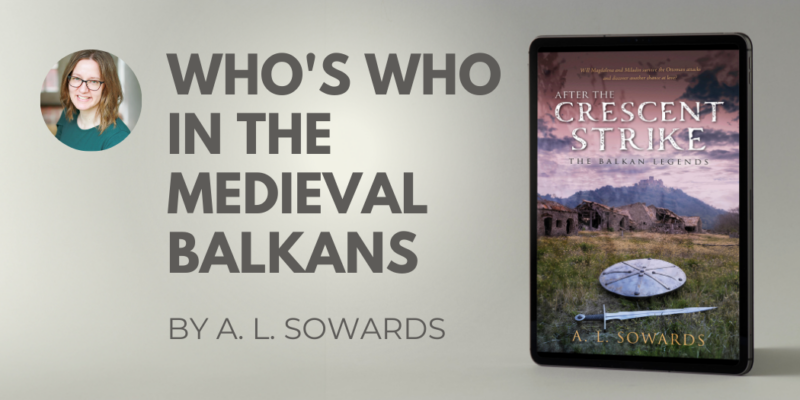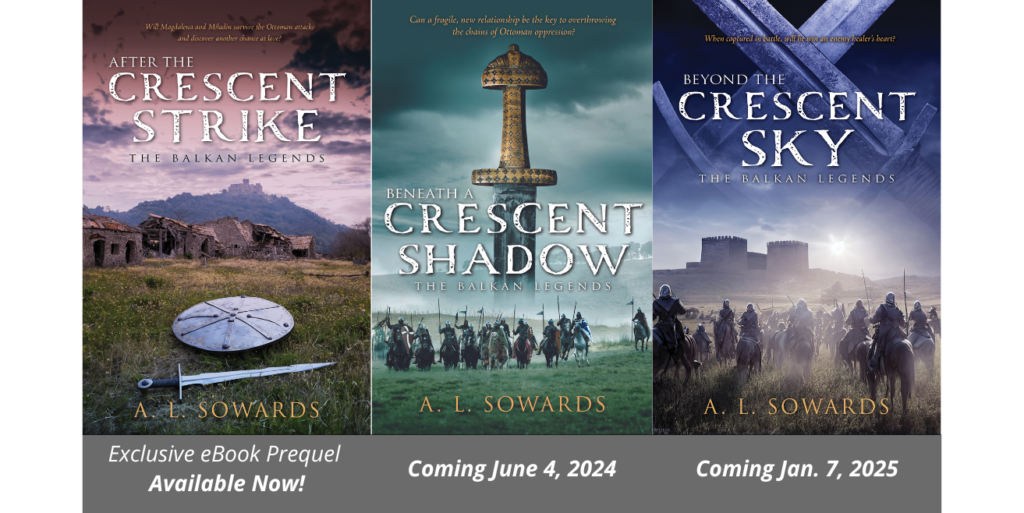
By A. L. Sowards, author of The Balkan Legends Series (After the Crescent Strike, Beneath a Crescent Shadow, Beyond the Crescent Sky, and Against a Crescent Storm)
When I tell people that I’ve written a historical fiction series set in the medieval Balkans, the most common response I hear is, “That’s unique.” Some people love the idea of reading something new. Others are a teeny bit intimidated by a setting that probably wasn’t covered in their high school history class. Yet most of us have seen enough movies or read enough books with a medieval-like setting that the fourteenth century isn’t quite as foreign as it sounds. People are still people, regardless of what century they lived in, and the range of human emotions has stayed steady throughout history. But to make it even easier for readers to jump into this set of stories that combines history, adventure, and romance, here’s a rundown of the major empires that play a role in The Balkan Legends series.
Most of my characters (fictional and historical) are drawn from three empires: the Serbian Empire, the Ottoman Empire, and the Byzantine Empire. Two were in decline in the late 1300s; one was on the rise and would eventually swallow the other two.

The Medieval Serbian Empire reached its zenith in the middle of the fourteenth century. The empire is remembered for trade, religious art and architecture, and a drive for religious autonomy and geographic expansion. The Serbs of this time were Orthodox Christian, and their culture was heavily affected by both Greek and Italian influences. The empire’s power began to decline with three events. First, the bubonic plague swept through Europe, killing as much as half of the population. Only a few years later, in 1355, the mighty Serb Emperor Stefan Dušan died. (His cause of death was likely poison, not plague.) Dušan’s son wasn’t strong enough to control the nobles, and as the various lords exerted more independent control over their lands, Serbian unity weakened. It was not a good time for dissension. The Ottoman Turks were expanding into Christian lands, and in 1371, they won a significant victory over a group of Serb nobles at the Battle of Maritsa. Yet despite the Serbian Empire’s division and decline, there was still enough strength left for one last epic battle at Kosovo—a battle that lives on in current Serbian history and legend, and in this series.
In the 1300s, the Ottoman Empire was relatively new to the Balkans. Its founder, Osman, established a realm in a portion of Asia Minor, his son Orhan extended it into Europe, and Osman’s grandson, Murad, expanded Ottoman control even farther. Under Murad, the sultan during most of the series, many of the Balkan Christian rulers were vassals to the Ottomans, but their hold was not yet complete, nor were the Ottoman’s rival Turkish tribes in Anatolia vanquished. The Ottomans were Muslims. Europe was a new frontier for them, a land of opportunity and destiny.

The Byzantine Empire was the eastern half of the Roman Empire. They never used the term “Byzantine.” Historians invented that term later. The Byzantines saw themselves as Romans, though many of their European neighbors referred to them as Greeks. The Byzantine capital was Constantinople, arguably the most incredible city in Christian Europe for a millennium. At one point, the Byzantine Empire controlled the Mediterranean world, but by the late 1300s, their borders had shrunk significantly. Though their military and political power was on the wane, their cultural influence remained strong. Their religion was Orthodox Christian, and faith played a prominent role in the culture.
In areas less central to the series, the French and the English were roughly in the middle of the Hundred Year’s War. Crécy and Poitiers were in the past. Agincourt and Joan of Arc were still to come. Catholic Hungary was a powerful force, at the time recovering from a messy succession crisis after the death of the Holy Roman Emperor Charles IV. Much of what is now Russia was under the rule of the Golden Horde, and large portions of the Middle East were part of the Mamluk Sultanate. Venice and Genoa were rival economic powers, with colonies and outposts throughout the Mediterranean and beyond.
If the political powers and technologies in The Balkan Legends are new to most readers, many of the themes will be familiar. Faith, a hunger for freedom, loyalty to family, and a desire to love and be loved all play out across the pages of the series, with a backdrop that means danger, intrigue, and treachery often lie less that a chapter away.

A. L. Sowards is the author of more than a dozen historical novels, with settings spanning the globe from the fourteenth to twentieth centuries. Her stories have earned multiple awards and other honors. Sowards grew up in Washington State, spent a few decades in Utah, and now resides in Alaska with her husband, three children, and ever-growing library. She likes hiking and swimming, usually manages to keep up with the laundry, and loves it when someone else cooks dinner.
NEW! AFTER THE CRESCENT STRIKE (Balkan Legends, Prequel eBook): Amidst Ottoman terror in 1371 Balkans, Magdalena and Miladin rekindle a romance once doomed by youth and circumstance, hidden threats draw ever closer. Before they can truly be safe, they must face a ruthless enemy who will stop at nothing to seize power.
